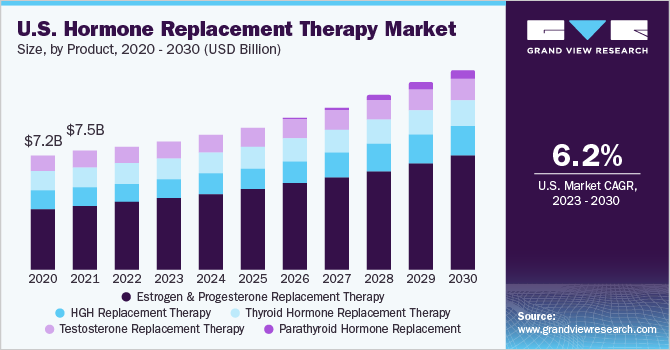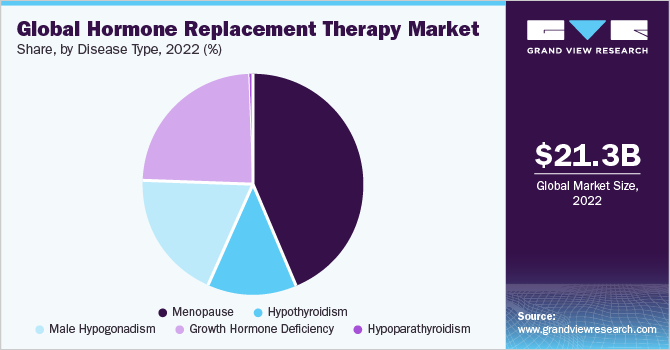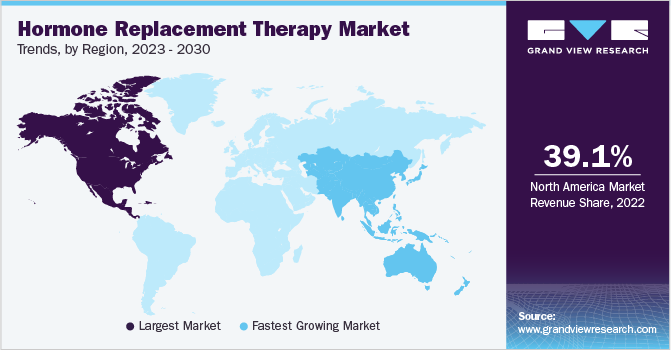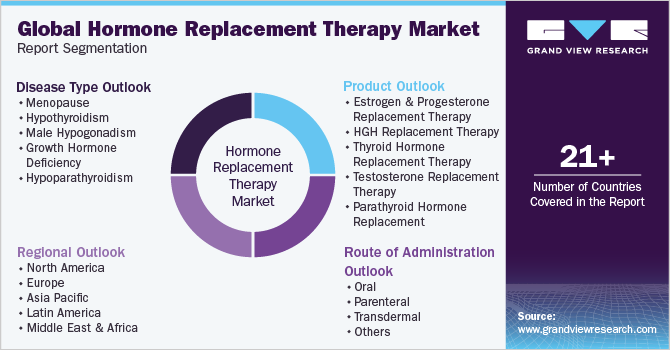- Home
- »
- Pharmaceuticals
- »
-
Hormone Replacement Therapy Market Size Report, 2030GVR Report cover
![Hormone Replacement Therapy Market Size, Share & Trend Report]()
Hormone Replacement Therapy Market Size, Share & Trend Analysis By Product (Estrogen & Progesterone Replacement Therapy), By Route of Administration, By Disease Type, By Region, And Segment Forecasts, 2023 - 2030
- Report ID: 978-1-68038-784-1
- Number of Report Pages: 123
- Format: PDF, Horizon Databook
- Historical Range: 2018 - 2021
- Forecast Period: 2023 - 2030
- Industry: Healthcare
Market Size & Trends
The global hormone replacement therapy market size was valued at USD 21.28 billion in 2022 and is expected to grow at a compounded annual growth rate (CAGR) of 6.6% from 2023 to 2030. The hormone replacement therapy (HRT) market is witnessing growth due to factors such as the rising incidence of target diseases and the availability of long-acting hGH products. According to American Thyroid Association, around 12.0% of the U.S. population is estimated to suffer from thyroid during their lifetime. It also reported that approximately 20.0 million U.S. citizens have some form of thyroid disease. Several studies showed that people who are on hormone replacement therapy are likely to have a low risk of COVID-19 infection and mortality rate.

A study led by the Oxford-Royal College of General Practitioners Research and Surveillance Centre studied 1.8 million medical records of women from 465 general practitioners and found 5,451 COVID cases linked with HRT (estrogen therapy treatment) witnessed a 78% reduction in infection and mortality rate. The male population tends to have a more severe infection and higher rates of hospitalization and mortality.
The increasing involvement of key players in the development of novel therapies is resulting in the introduction of new products. For instance, in January 2022, Ascendis Pharma A/S received European Commission's market authorization for its drug SKYTROFA for the treatment of children and adolescents suffering from growth hormone disorders. This product is the first once-weekly treatment for growth hormone deficiency in the pediatric population.
Increasing awareness about hormone deficiency and disorders is expected to propel market growth. For instance, the Child Growth Foundation is a UK-based non-government organization dedicated to supporting people living with rare growth hormone disorders. This organization provides information and support to patients, caregivers, & healthcare professionals to improve patients' quality of life.
However, the high cost associated with hormonal replacement therapy treatment may restrain the growth of the market. For instance, hormone replacement therapy injectable annually costs around USD 288 to USD 1,440 for insured patients and USD 480 to USD 4,800 for uninsured patients.
Product Insights
Based on product, the HRT market is segmented into estrogen & progesterone replacement therapy, hGH replacement therapy, thyroid replacement therapy, parathyroid hormone replacement, and testosterone replacement therapy. The estrogen and progesterone replacement therapy segment held the highest market share of 54.34% in 2022. The dominance was attributed due to an increase in the number of women suffering from menopause. According to the American Congress of Obstetricians and Gynecologists, around 6,000 women reach menopause daily in the U.S.
The parathyroid hormone replacement segment is expected to witness the fastest growth during the forecast period owing to rising incidence and increasing product penetration. According to the National Organization for Rare Disease 2021 database, around 70,000 people in the U.S. are living with hypoparathyroidism. In the parathyroid hormone segment, only one product has been approved, i.e., Natpara.
Route Of Administration Insights
Based on route of administration, HRT market is segmented into oral, parenteral, transdermal, and others. The oral segment dominated the market with a share of 42.48% in 2022 due to high prescription rate and ease of administration. Most HRT products generally include pills & tablets.
The parenteral segment is expected to witness lucrative growth during the forecast period. An improvement in drug delivery through parenteral modes, such as pen-based drug delivery, is anticipated to improve patient compliance and facilitate ease of administration, driving the segment growth. Some of the popular products available in pen form include Genotropin Mixer Pen, Norditropin FlexPro Pen, and Humatrope HumatroPen.
Moreover, the launch of a new long-acting growth hormone injection is also expected to drive segment growth. For instance, in January 2022, Pfizer, Inc. and OPKO Health, Inc. received approval from the Ministry of Health, Labour and Welfare, Japan, for the commercialization of NGENLA to treat growth hormone disorder. This product is the next-generation long-acting growth hormone injection, with a treatment frequency of a once-a-week dosage.
Disease Type Insights
Based on disease type, HRT market has been segmented into menopause, male hypogonadism, hypothyroidism, growth hormone deficiency, and hypoparathyroidism. The menopause segment dominated the market in 2022 with a share of 44.44%. This can be attributed to the owing to increase in the number of women suffering from menopause.

According to the UN's 2020 global estimates, 958 million women were aged 50 and above. By 2050, this number is expected to reach 1.65 million. Millions of women are likely to spend more than one-third of their lives after menopause in the future. However, menopause age varies based on various factors; natural factors, such as habitat and genetics, change the age of menopause in individuals to some extent.
The hypoparathyroidism segment is expected to witness significant growth during the forecast period owing to an increase in novel treatments and the introduction of products. For instance, in September 2020, Ascendis Pharma A/S showcased the TransCon technologies at the American Society for Bone and Mineral Research (ASBMR) 2020 Annual Meeting. It also published the top-line results of the phase 2 clinical trial for TransCon PTH at the annual meeting. The drug is currently in phase 3 clinical trials. The approval and subsequent launch of this product will provide more options available for parathyroid hormone replacement.
Regional Insights
North America dominated the global hormone replacement therapy market with a share of 39.15% in 2022 and is anticipated to grow at a significant rate over the forecast period. Major product launches, collaborative agreements between manufacturers, and favorable reimbursement policies are among the factors responsible for the largest market share in the region. For instance, in August 2020, U.S. FDA approved Sogroya (somapacitan-beco) a HGH replacement therapy product developed by Novo Nordisk A/S. This product is administered once a weekly through subcutaneous route in adults diagnosed with growth hormone deficiency.

The Asia Pacific is estimated to be the fastest-growing region over the forecast period. As per Journal of the North American Menopause Society (May 2022), the prevalence of vasomotor symptoms associated with menopause has been reported to range from 43% to 83% in women in East Asian countries. Thus, growing number of women reaching menopause is expected to drive the demand for hormone replacement therapy in the region.
Key Companies & Market Share Insights
Key companies are undertaking strategic initiatives to address the growing demand for hormone replacement therapy products. In November 2021, I-MAB Biopharma Co., Ltd. entered into a collaboration with Jumpcan Pharmaceutical Group for the development & commercialization of eftansomatropin alfa (TJ101) in China. TJ101 is a long-acting recombinant human growth hormone, which is currently under phase 3 clinical trial for the treatment of pediatric growth hormone deficiency. This collaboration is expected to strengthen its position in the hormone replacement therapy market. Additionally, in February 2023, Korea’s Ministry of Food and Drug Safety approved Pfizer’s NGENLA for the treatment of growth hormone deficiency. Some of the key players in the global hormone replacement therapy market include:
-
Eli Lilly and Company
-
Bayer AG
-
Noven Pharmaceuticals, Inc.
-
Pfizer Inc.
-
Merck & Co., Inc.
-
Viatris, Inc.
-
Novo Nordisk A/S
-
F. Hoffmann-La Roche Ltd.
-
ASCEND Therapeutics US, LLC.
- AbbVie, Inc.
Hormone Replacement Therapy Market Report Scope
Report Attribute
Details
Market size value in 2023
USD 22.34 billion
Revenue forecast in 2030
USD 35.60 billion
Growth rate
CAGR of 6.6% from 2023 to 2030
Base year for estimation
2022
Historical data
2018 - 2021
Forecast period
2023 - 2030
Quantitative units
Revenue in USD billion and CAGR from 2023 to 2030
Report coverage
Revenue forecast, company ranking, competitive landscape, growth factors, and trends
Segments covered
Product, route of administration, disease type, region
Regional scope
North America; Europe; Asia Pacific; Latin America; MEA
Country scope
U.S.; Canada; Germany; U.K.; France; Italy; Spain; Denmark; Sweden; Norway; China; Japan; India; Australia; South Korea; Thailand; Brazil; Mexico; Argentina; South Africa; Saudi Arabia; UAE; Kuwait
Key companies profiled
Bayer AG; Pfizer Inc.; Merck & Co., Inc.; Viatris, Inc.; Novo Nordisk A/S; Eli Lilly and Company; F. Hoffmann-La Roche Ltd; Noven Pharmaceuticals, Inc.; ASCEND Therapeutics US, LLC.; AbbVie, Inc.
Customization scope
Free report customization (equivalent up to 8 analyst’s working days) with purchase. Addition or alteration to country, regional & segment scope.
Pricing and purchase options
Avail customized purchase options to meet your exact research needs. Explore purchase options
Global Hormone Replacement Therapy Market Report Segmentation
This report forecasts revenue growth and provides an analysis on the latest trends in each of the sub-segments from 2018 to 2030. For the purpose of this report, Grand View Research has segmented the hormone replacement therapy market on the basis of product, route of administration, disease type, and regions:

-
Product Outlook (Revenue, USD Billion, 2018 - 2030)
-
Estrogen & Progesterone Replacement Therapy
-
HGH replacement therapy
-
Thyroid hormone replacement therapy
-
Testosterone Replacement Therapy
-
Parathyroid Hormone Replacement
-
-
Route of Administration Outlook (Revenue, USD Billion, 2018 - 2030)
-
Oral
-
Parenteral
-
Transdermal
-
Others
-
-
Disease Type Outlook (Revenue, USD Billion, 2018 - 2030)
-
Menopause
-
Hypothyroidism
-
Male hypogonadism
-
Growth hormone deficiency
-
Hypoparathyroidism
-
-
Regional Outlook (Revenue, USD Billion, 2018 - 2030)
-
North America
-
U.S.
-
Canada
-
-
Europe
-
Germany
-
UK
-
France
-
Italy
-
Spain
-
Denmark
-
Sweden
-
Norway
-
-
Asia Pacific
-
Japan
-
China
-
India
-
Australia
-
South Korea
-
Thailand
-
-
Latin America
-
Brazil
-
Mexico
-
Argentina
-
-
Middle East and Africa (MEA)
-
South Africa
-
Saudi Arabia
-
UAE
-
Kuwait
-
-
Frequently Asked Questions About This Report
b. The global hormone replacement therapy market size was valued at USD 21.28 billion in 2022 and is anticipated to reach USD 22.34 billion in 2023.
b. The global hormone replacement therapy market is expected to witness a compound annual growth rate of 6.6% from 2023 to 2030 to reach USD 35.60 billion by 2030.
b. North America dominated the hormone replacement market with a share of 39.1% in 2022. This is attributable to major product launches, collaborative agreements between manufacturers, and favorable reimbursement policies.
b. Some of the key players in the hormone replacement therapy market are Eli Lilly and Company; Bayer AG; Noven Pharmaceuticals, Inc; Pfizer Inc.; Merck & Co., Inc.; Viatris, Inc.; Novo Nordisk A/S; F. Hoffmann-La Roche Ltd.; ASCEND Therapeutics US, LLC.; and AbbVie, Inc.
b. The major factors driving hormone replacement therapy market growth are the rising prevalence of target disease, increasing uptake of parathyroid hormone replacement therapy, and approval of long-acting human growth hormone drugs.
Share this report with your colleague or friend.
![gvr icn]()
NEED A CUSTOM REPORT?
We can customize every report - free of charge - including purchasing stand-alone sections or country-level reports, as well as offer affordable discounts for start-ups & universities. Contact us now
![Certified Icon]()
We are GDPR and CCPA compliant! Your transaction & personal information is safe and secure. For more details, please read our privacy policy.
We are committed towards customer satisfaction, and quality service.
"The quality of research they have done for us has been excellent."





